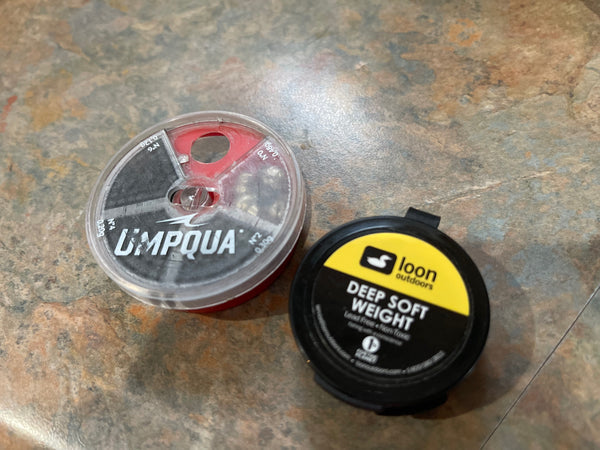I've been fly fishing for years, and while it's always been an enjoyable pastime, I can remember discovering a game-changing technique that has made a huge difference in my success on the water. Split shot, a small piece of metal or metallic paste that adds weight to your tippet or leader, has completely transformed my fly fishing game. Not only does it allow me to get my fly pattern to the optimal feeding zones more quickly, but it also enables me to make more extended drops and paired with weighted flies.
You can see a tangle of split shot along the rod in the char cover image. This is one downfall of split shot but the moment was worth untangling.
The basics of split shot in fly fishing are relatively simple. Adding weight to your tippet or leader allows your fly to sink faster, which can be essential when fishing deeper waters or when targeting fish that are holding near the bottom. Split shot is a versatile tool that can be used in a variety of fishing scenarios, from nymphing to streamer fishing. It's also easy to use and adjust as needed, making it an excellent option for anglers of all skill levels.
Selecting the right split shot and strategically placing it on your rig can make all the difference in your success on the water. In this article, I'll share my personal experience with split shot, including tips and tricks for using it effectively, as well as some common issues to troubleshoot. Whether you're a seasoned angler or just starting, split shot is a technique that can take your fly fishing to the next level.
Key Takeaways
- Split shot is a versatile tool that can be used in a variety of fishing scenarios, from nymphing to streamer fishing.
- Selecting the right split shot and strategically placing it on your rig can make all the difference in your success on the water.
- Split shot is an excellent option for anglers of all skill levels and can take your fly fishing game to the next level.
The Basics of Split Shot in Fly Fishing
When I first started fly fishing, I was hesitant to use split shot. I thought that it would make my presentation look unnatural and that it would spook the fish. However, after some experimentation, I discovered that split shot can be an incredibly useful tool for fly fishing.
Split shot is a small, weighted sinker that can be added to your leader or tippet to help your fly sink to the desired depth. It is especially useful when fishing in fast-moving water or when trying to get your fly down to the bottom quickly.
There are a few different types of split shot available, including lead, tin, and tungsten. Lead is the most common and least expensive, but it can be harmful to the environment. Tin is a good alternative to lead, but it is not as dense and may not sink as quickly. Tungsten is the most expensive but is also the densest and sinks the fastest. Lastly and a new favorite and different style or form is the sinking putty. It's even easer to add and remove than the standard split shot pellets.
When using split shot, it's important to place it correctly on your leader or tippet. You want to avoid placing it too close to your fly, as this can make your presentation look unnatural. Instead, place it a few inches above your fly and adjust the amount of split shot as needed to achieve the desired depth.
Overall, I've found that using split shot has greatly improved my fly fishing success. It allows me to get my fly down to the fish quickly and effectively, and I've had many more bites since incorporating it into my fly fishing arsenal.
Selecting the Right Split Shot
When I started using split shot in my fly fishing, I quickly realized that selecting the right split shot is crucial to the success of my fishing. Here are some things to consider when selecting the right split shot for your fly fishing needs.
Weight and Size Considerations
The weight and size of your split shot will depend on the type of fish you are targeting and the depth of the water you are fishing in. Heavier split shot will sink your fly faster, while lighter split shot will allow your fly to float higher in the water column.
It's important to experiment with different weights and sizes of split shot to find the right balance for your specific fishing situation. Keep in mind that using too much weight can cause your fly to sink too quickly and become snagged on the bottom, while using too little weight can make it difficult to get your fly down to the desired depth. It's a gentle balance and comes with more and more experimentation. I learned a motto that if you aren't hitting bottom every 10 casts, then there isn't enough weight.
Material and Design Variations
Split shot come in a variety of materials and designs, each with its own unique features. As mentioned previously, some common materials include lead, tin, and tungsten. Lead split shot are the most common, but some anglers prefer to use tin or tungsten because they are environmentally friendly and denser than lead.
In terms of design, there are several different types of split shot available, including round, oval, and removable. Round split shot are the most common and easiest to use, while oval split shot are designed to create less resistance when casting. Removable split shot can be easily added or removed from your line without having to cut and re-tie your leader. And again the last and my new tendency is to use tungsten or lead putty. The putty allows me to add and remove weight very easily in comparison to the small shots. A tip I use is to add the weight and put the line with the weight on it into the water for a few seconds. The cooling of the putty makes it adhere and stay on the line a bit better.

Overall, selecting the right split shot is an important part of fly fishing. By considering the weight and size of your split shot, as well as the material and design variations, you can improve your chances of catching more fish and having a successful day on the water.
Strategic Placement of Split Shot
When I started using split shot in my fly fishing, it completely changed the game for me. One of the most important things I learned about using split shot is the strategic placement of the weights on my fishing line. Here are a few key things to keep in mind when placing split shot on your line:
Depth and Current Adjustments
The first thing to consider when placing split shot is the depth of the water you are fishing in. The deeper the water, the more weight you will need to get your fly down to the fish. Additionally, the speed of the current will also affect how much weight you need. If the current is strong, you will need more weight to keep your fly down.
To make adjustments for depth and current, start by adding a small amount of weight and casting your line. If your fly is not getting down to the fish, add more weight and try again. If your fly is sinking too quickly and hitting the bottom, remove some weight and try again. Keep adjusting until you find the right balance.
In addition to the depth, determine where you want the weight in alignment with your flies. I like mine only 6-12 inches above my flies in some situations for nymphing. Other times I'll add an additional tag with a triple surgeons and add the weight there. A tip when adding split shot to a tag end is to tie a few quick overhands on the end of it so the split shot can use them as stopper knots. This will keep weight from sliding down and off the tag. Lastly, when streamer fishing I often put weight right up against the fly. Yet, again, I'll change that to a few inches if I want to see a jigging action on the fly.
Split Shot Patterns for Success
Another important thing to keep in mind when placing split shot is the pattern you use. There are a few different patterns that can be effective, depending on the type of water you are fishing in and the type of fish you are targeting.
One common pattern is to use a single split shot about 12-18 inches above your fly. This is a good pattern for slow-moving water and for fish that are not too deep. Another pattern is to use multiple split shots spaced out along your line. This is a good pattern for fast-moving water and for fish that are deeper.
Where I fish there are tons of baby head sized rocks in the substrate so I like to arange my shot in a pattern of small beads that are all up against each other in a line. This allows the split shot to slink over the rocks and keeps it from ending up chalked between two rocks on the bottom.
Overall, the strategic placement of split shot on your fishing line can make a big difference in your success as a fly fisherman. By making adjustments for depth and current and using effective split shot patterns, you can increase your chances of catching more fish.
FFIP does receive a small commission from affiliate sales links. However, not all links are directed towards affiliate programs as I stay neutral and base recommendations more so on my own experiences. These commissions are used to support the FFIP expenses related to maintaining and hosting the show, blog, etc. Thank you for your support and by purchasing through the links within my articles when applicable!

By Christian Bacasa
Host of the Fly Fishing Insider Podcast
Fly Fishing Insider Podcast Official Website
Instagram Fly Fishing Insider Podcast
Instagram Dupeafish
Facebook
Pinterest
Twitter
LinkedIn
Tumblr
Watch on YouTube






